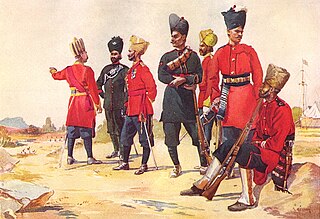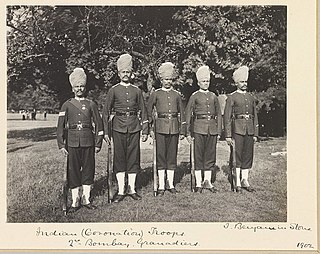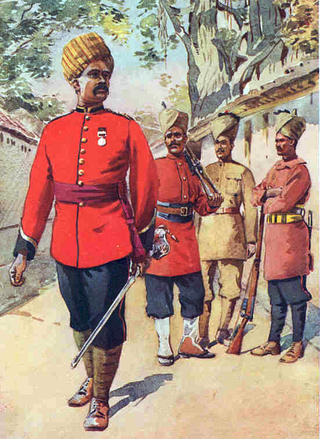
The 101st Grenadiers was a regiment of the British Indian Army.

The 119th Infantry (The Mooltan Regiment) was an infantry regiment of the British Indian Army. The regiment originated in 1817, when it was raised as the 1st Battalion, 10th Regiment of Bombay Native Infantry.
The 108th Infantry were an infantry regiment of the British Indian Army. The regiment traces their origins to 1768, when they were raised as the 1st Battalion, Bombay Sepoys.

The 109th Infantry was an infantry regiment of the British Indian Army. The regiment traces its origins to 1768, when it was raised as the 5th Battalion, Bombay Sepoys.

The 112th Infantry were an infantry regiment of the East India Company's Bombay Army and later the British Indian Army. The regiment traces their origins to 1796, when they were raised as the 2nd Battalion, 6th Regiment of Bombay Native Infantry.

The 113th Infantry were an infantry regiment of the British Indian Army. The regiment traces their origins to 1800, when they were raised as the 1st Battalion, 7th Regiment of Bombay Native Infantry.

The 104th Wellesley's Rifles were an infantry regiment of the British Indian Army. They could trace their origins to 1775, when they were raised as the 5th Battalion, Bombay Sepoys and presently its designation is 3 Guards of Indian Army.

The 24th Punjabis were an infantry regiment of the British Indian Army. It was raised in 1857, as the 11th Regiment of Punjab Infantry. It was designated as the 24th Punjabis in 1861 and became 4th Battalion 14th Punjab Regiment in 1922. In 1947, it was allocated to the Pakistan Army, where it continues to exist as 8th Battalion (CRACKS) The Punjab Regiment.

The 25th Punjabis was an infantry regiment of the British Indian Army. It was raised in 1857, as the 17th Regiment of Punjab Infantry. It was designated as the 25th Punjabis in 1903 and became 1st Battalion 15th Punjab Regiment in 1922. In 1947, it was allocated to the Pakistan Army, where it continues to exist as 9th Battalion The Punjab Regiment.

The 28th Punjabis were an infantry regiment in the British Indian Army. It was raised in 1857, as the 20th Regiment of Punjab Infantry. It was designated as the 28th Punjabis in 1903 and became 4th Battalion 15th Punjab Regiment in 1922. In 1947, it was allocated to the Pakistan Army, where it continues to exist as 12th Battalion The Punjab Regiment.

The 61st Pioneers were an infantry regiment of the British Indian Army. They trace their origins to 1758, when they were raised as the 1st Battalion Coast Sepoys.

The 102nd Prince of Wales's Own Grenadiers was an infantry regiment of the British Indian Army. It could trace its origins to 1796, when it was raised as the 13th Battalion, Bombay Native Infantry.
The 81st Pioneers were an infantry regiment of the British Indian Army. They could trace their origins to 1786, when they were raised as the 28th Madras Battalion.

The 105th Mahratta Light Infantry were an infantry regiment of the British Indian Army. The regiment traces their origins to 1768, when they were raised as the 3rd Battalion, Bombay Sepoys.

The 107th Pioneers were an infantry regiment of the British Indian Army. Their origin can be traced back to 1788, when they were raised as the 4th Battalion, Bombay Sepoys.

The 110th Mahratta Light Infantry were an infantry regiment of the British Indian Army. The regiment traces their origins to 1797, when they were raised as the 2nd Battalion, 5th (Travancore) Regiment of Bombay Native Infantry.

The 114th Mahrattas were an infantry regiment of the British Indian Army. The regiment traces their origins to 1800, when they were raised as the 2nd Battalion, 7th Regiment of Bombay Native Infantry.

The 116th Mahrattas were an infantry regiment of the British Indian Army. The regiment traces their origins to 1800, when they were raised as the 2nd Battalion, 7th Regiment of Bombay Native Infantry.

The 117th Mahrattas were an infantry regiment of the British Indian Army. The regiment traces their origins to 1800, when they were raised as the Bombay Fencible Regiment.
The 121st Pioneers were an infantry regiment of the East India Company's Bombay Army and later the British Indian Army. The regiment traces their origins to 1777, when they were raised as the Marine Battalion.










